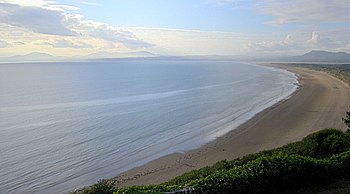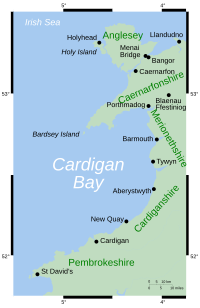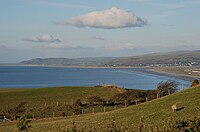Cardigan Bay: Difference between revisions
No edit summary |
|||
| Line 37: | Line 37: | ||
{{reflist}} | {{reflist}} | ||
[[Category: | [[Category:Cardigan Bay| ]] | ||
[[Category:Irish Sea]] | |||
Latest revision as of 10:29, 9 June 2018


Cardigan Bay is a large inlet of the Irish Sea, indenting the west coast of Wales between Bardsey Island in the north, and Strumble Head, Pembrokeshire at its southern end. It is named after Cardigan or its county, Cardiganshire which latter shire curves around much of the southern stretch of the bay.
It is the largest bay in Wales[1] and lies on the coasts of four counties; Pembrokeshire, Cardiganshire, Merionethshire and Caernarfonshire.
Cardigan Bay has numerous beaches, and a unique marine life. From the coast path it is often possible to observe bottlenose dolphins, porpoises and Atlantic grey seals.[2] The Bay has the largest population of bottlenose dolphins around the coasts of the United Kingdom.[3]
Much of the coast surrounding the bay is fertile farmland, dotted with towns and seaside resorts such as Fishguard, New Quay, Aberaeron, Llanon, Aberystwyth, Borth, Aberdovey, Tywyn, Barmouth, Porthmadog and Pwllheli.
Major rivers flowing into the bay include the Glaslyn, Teifi, Rheidol, Dovey, Aeron, Dysynni and Mawddach. Three deep-cut estuaries open into the bay; those of the Dovey between Cardiganshire and Merionethshire, the Mawddach in Merioneth and the Glaslyn between Merionethshire and Caernarfonshire.

Up until the early 20th century, Cardigan Bay supported a strong maritime industry. Cardigan stands at the mouth of the River Teifi and at the turn of the nineteenth century, the heyday of the port, it was a more important port than Cardiff. At this time more than 300 ships were registered at Cardigan - seven times as many as Cardiff, and three times as many as Swansea.[4]
Cantre'r Gwaelod
It is said in legend that Cardigan Bay was once dry land. The central and northern areas of the Bay are the location of the legendary Cantre'r Gwaelod, the drowned "Lowland Hundred" or "Hundred under the Sea".
Several versions of the myth come down to us today; the oldest in the poem '‘Boddi Maes Gwyddneu’' or '‘Seithennin’' written in the mid-13th century. This version of the legend say that a sea-wall held the waters back from the land but one night a gate was left open and the seas poured in and overthrew the whole land of Cantre’r Gwaelod, which was forever lost beneath the rolling waters. The legend has inspired poetry over the ages:
When waves crashed on the sea-shore
With thunder in its wake
The bells of Cantre'r Gwaelod
Are silent 'neath the wave
- Clychau Cantre'r Gwaelod by J J Williams (1869–1954)
The hardened stumps of an ancient forest found along the tide line at various points along the bay seem to approve the legend,[5] and no doubt in ages when the sea was lower there was indeed woodland and pasture stretching out over what are now the shallow waters of Cardigan Bay.
Outside links
- General information
- Cardiganshire coast
- Dolphin video, sounds and pictures
- Atlantic Grey Seals and pictures